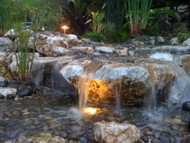How To Systematically Find a Pond Leak
Published by Dan on Aug 7th 2018
Finding a leak in a pond can be really frustrating. You just know that
the water is disappearing faster than it should be,but you do not see a
wet spot anywhere along the sides. You wonder if this is normal
evaporation or if this is a big leak
and you worry about how much your water bill is going to be or if
excessive new water additions of water might contain excessive chlorine
or chloramines.
Pond leaks can be a very frustrating part of pond ownership. However, if they are approached
systematically, they usually can be found and corrected quickly. Keep in mind that most pond leaks
will not be found in the pond itself. They are usually constructed with tough materials such as thick
rubber that don’t spontaneously spring leaks for no reason. However, they can be damaged by
dropping heavy boulders on them (usually during the construction phase), or even by heavy branches
from overhead trees that may fall in during a storm. On occasion, animals such as a chipmunks and
voles, will make its home among the rocks of the pond edge, and will chew a hole through the liner.
Most all pond leaks occur along the pond and stream edges. Areas that were raised by adding
additional soil during the construction of the pond will be the most vulnerable due to natural settling of
the soil. The way to fix these areas is to raise the liner and pack more soil behind it. However, if the
leak is not found by looking for telltale wet areas, then the following steps will help you to find it using
a systematic approach.
1. Look around edges of the pond and along streams for wet areas. This will occur if water is
escaping over the liner edge.
2. Fill pond and turn off waterfall. Wait for several hrs to see if level drops. If level drops, leave
alone until it stops dropping. That will show level along the edge where the hole is.
3. If the pond is outfitted with a skimmer, check valve assembly, and waterfall box; monitor the
water level in the waterfall. If it drops than this will give you an indication that there may be a
leak is in the plumbing between the pump and waterfall box.
4. If water level in the pond does not drop, then leak is in waterfall or stream area. Turn the pump
back on and check along stream edges and waterfalls. Also check the back of the waterfall
box to make sure water is not running out over the back due to settling.
5. If a hole in the liner is found to be the source of the leak, simply fix as follows:
• Drain water until hole is exposed.
• Clean liner thoroughly.
• Apply a small amount of EPDM Tape Primer.
• Install a rubber patch that will extend a few inches over the hole.
• For larger holes, apply a patch on both sides of the liner.
• Refill pond and recheck for leaks.
If the leak is found in the pipe going to the waterfall box, simply cut the pipe where the leak is and install a coupling designed for use with PVC pipe. Again, the most
important thing when trying to find and resolve a leak in a water garden
is to follow a systematically check of all the components as described
above. The sooner you find the problem and correct it, the sooner you
can turn your system back on and start to enjoy your water feature
again.
Your fish will thank you for it too!

